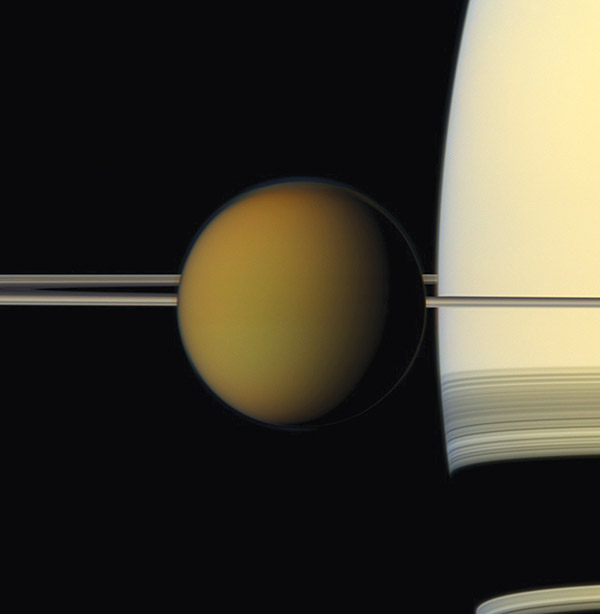
Saturn’s largest moon, Titan, is an icy world dominated by extensive sand dunes at the equator, methane-filled lakes near the poles, and vast networks of dry riverbeds in between. Wrapped in a nitrogen atmosphere thicker than Earth’s, Titan is an ideal test bed for studying planetary climate models for UCLA Assistant Professor Jonathan Mitchell.
“Titan is probably the most Earth-like place in the solar system in terms of its very active weather cycle,” said Mitchell. But a weather forecaster on chilly Titan would be more likely to predict a liquid methane downpour than the water-based showers we are accustomed to on Earth. “Titan is too cold for water to play a role in the weather. Instead, it rains and hails methane, the natural gas we use as fuel for our stoves,” Mitchell said.
So is Titan a veritable tinder box, an enormous gas leak ready to catch fire at the slightest spark? Not at all, said Mitchell. “You might worry about it exploding, but all the oxygen is locked up into water. If you wanted a lighter that you could carry around on Titan, then you’d carry around a flint with a little vial of oxygen because there is plenty of methane in the air and the limiting ingredient is the oxygen for combustion.”
Titan has surface temperatures nearly 300 degrees Fahrenheit below zero (-180° Celsius). Water makes up about half the solid body by mass, and where you would expect to find a rocky crust on a terrestrial planet like Earth, Titan’s surface layers are composed mainly of ice. “Water is essentially Titan’s rock,” said Mitchell. “These temperatures are so far beyond the realm of human experience that they’re hard to even grasp.”
Despite the frigid conditions, Titan’s climate patterns are technically quite tropical, Mitchell said. “On Earth, we have a certain temperature difference between the equator and the poles which gives rise to vastly different climates on the surface, like tropical islands versus Antarctica,” he said. “On Titan, this temperature difference is essentially erased, which makes its climate all tropics.” The subzero weather results from the fact that Titan spins more slowly than Earth, taking sixteen days to complete a full rotation, and also because of its smaller size. While Titan is larger than Mercury and is the second largest moon in the solar system, it is still less than half the size of Earth.
To be able to understand and predict weather patterns on Titan, Mitchell and his colleagues rely on observations from NASA’s Cassini spacecraft that help them improve their computer simulations. “We’re looking at the visible and near-infrared images of Titan to survey cloud features and find interesting spatial patterns from the evolution of storms,” Mitchell said. Because Cassini can only take measurements at Titan during its regular flyby once every few weeks, an accurate computer model is critical to understanding weather patterns on the icy body.
Mitchell’s research may help explain a curious phenomenon called super-rotation, which causes Titan’s atmosphere to circle the planet at speeds higher than expected. “Super-rotation means that the atmosphere as a whole is spinning faster than the planetary surface,” Mitchell said. “This is puzzling because we typically think an atmosphere gains its momentum from friction with the surface.”
Since coming to UCLA in 2009, Mitchell has expanded his work to include Earth’s ancient climate, which he hopes will help him to better predict how regional climates will change as the planet warms over the next century. “We’ve essentially nailed the problem of anthropogenic greenhouse gases warming the planet,” Mitchell said. “The much harder question is: what will be the resulting impacts?”
Mitchell grew up in rural Iowa where incessant gazing at the stars as a small child led to the occasional tripping injury. “I’ve always been curious, and that’s what made me a scientist,” Mitchell said. “I was destined to be looking up.” As a graduate student at the University of Chicago, Mitchell originally studied cosmology and gravitational lensing. But after a few years, he switched fields to study the physics of climate on Earth and other planets. “Cassini was arriving at Saturn about that time so I decided to take a pit stop at Titan, and I haven’t really left since,” he said.
Mitchell, who enjoys singing in small group ensembles in his spare time, has found a home at UCLA. “Academically, I just can’t imagine a better fit for me. I have very broad interests and UCLA is a place where you can really expand and learn.”
Watch a video profile of Jonathan Mitchell here. Learn more about his research here.
Follow Iplex
